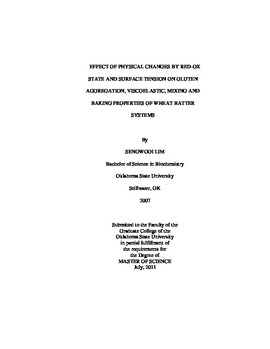| dc.contributor.advisor | Rayas-Duarte, Patricia | |
| dc.contributor.author | Lim, Sengwooi | |
| dc.date.accessioned | 2014-04-15T20:12:56Z | |
| dc.date.available | 2014-04-15T20:12:56Z | |
| dc.date.issued | 2011-07-01 | |
| dc.identifier.uri | https://hdl.handle.net/11244/8838 | |
| dc.description.abstract | The aggregation properties gluten proteins in batters were studied by modifying the surface tension and disulfide bonds of flour batter by the addition of DATEM, ascorbic acid, and dithiothreitol. The properties of aggregation were analyzed with a gluten agglomeration test. Associations of flour protein, agglomeration, viscoelastic, mixing and baking properties were also analyzed by principal component analysis. Decrease in surface tension by the addition of DATEM greatly increased the total work of agglomeration (area under the peak). The different responses due to decrease of surface tension will assist in making inferences on the nature of the different structures and interactions strength that the gluten forms in a batter system. The oxidation of gluten proteins by the addition of ascorbic acid also highly influenced the total work of agglomeration (area under the peak). The effect of oxidation of gluten proteins on area under the peak showed a maximum value at 50 ppm and a steady decrease with increased of oxidation level. Overall, PCA suggested that agglomeration properties of flour batters were highly associated to loaf volume and specific volume of baked pup loaves. The reduction of disulfide bonds on gluten protein by the addition of DTT increased the work of agglomeration (area under the peak) of flour batters with the lowest reduction levels with 0.1 mM DTT. Gluten agglomeration test appears to be a promising tool to separate flour properties. The combined PCA also showed that flour protein explained the highest variance followed by batter agglomeration strength (maximum torque) and torque after aggregation. Reduction of disulfide bonds on gluten also increased the viscous behavior of all batter systems. Overall, the gluten agglomeration test is relatively fast and uses small sample size; therefore it has some advantages over more time consuming tests (mixing and baking tests) used at the present time in flour quality evaluation settings. | |
| dc.format | application/pdf | |
| dc.language | en_US | |
| dc.publisher | Oklahoma State University | |
| dc.rights | Copyright is held by the author who has granted the Oklahoma State University Library the non-exclusive right to share this material in its institutional repository. Contact Digital Library Services at lib-dls@okstate.edu or 405-744-9161 for the permission policy on the use, reproduction or distribution of this material. | |
| dc.title | Effect of Physical Changes on Red-ox State and Surface Tension on Gluten Aggregation, Viscoelastic, Mixing and Baking Properties of Wheat Batter Systems | |
| dc.type | text | |
| dc.contributor.committeeMember | McGlynn, William | |
| dc.contributor.committeeMember | Bowser, Tim | |
| osu.filename | Lim_okstate_0664M_11671.pdf | |
| osu.college | Agricultural Sciences and Natural Resources | |
| osu.accesstype | Open Access | |
| dc.description.department | Department of Food Science | |
| dc.type.genre | Thesis | |
